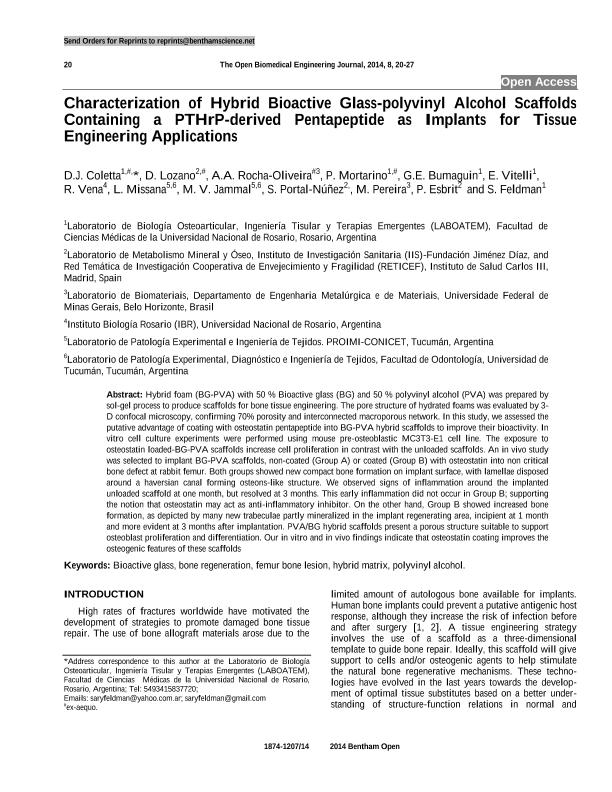Artículo
Characterization of hybrid Bioactive glass-polyvinyl alcohol scaffolds containing a PTHrP-derived pentapeptide as implants for tissue engineering applications
Coletta, Dante Jesus ; Lozano, D.; Rocha Oliveira, A. A.; Mortarino, P.; Bumaguin, G. E.; Vitelli, E.; Vena, Rodrigo
; Lozano, D.; Rocha Oliveira, A. A.; Mortarino, P.; Bumaguin, G. E.; Vitelli, E.; Vena, Rodrigo ; Missana, Liliana Raquel
; Missana, Liliana Raquel ; Jammal, María Victoria
; Jammal, María Victoria ; Portal Núñez, S.; Pereira, M.; Esbrit, P.; Feldman, Susana Raquel
; Portal Núñez, S.; Pereira, M.; Esbrit, P.; Feldman, Susana Raquel
 ; Lozano, D.; Rocha Oliveira, A. A.; Mortarino, P.; Bumaguin, G. E.; Vitelli, E.; Vena, Rodrigo
; Lozano, D.; Rocha Oliveira, A. A.; Mortarino, P.; Bumaguin, G. E.; Vitelli, E.; Vena, Rodrigo ; Missana, Liliana Raquel
; Missana, Liliana Raquel ; Jammal, María Victoria
; Jammal, María Victoria ; Portal Núñez, S.; Pereira, M.; Esbrit, P.; Feldman, Susana Raquel
; Portal Núñez, S.; Pereira, M.; Esbrit, P.; Feldman, Susana Raquel
Fecha de publicación:
07/03/2014
Editorial:
Bentham Science Publishers
Revista:
Open Biomedical Engineering Journal
ISSN:
1874-1207
Idioma:
Inglés
Tipo de recurso:
Artículo publicado
Clasificación temática:
Resumen
Hybrid foam (BG-PVA) with 50 % Bioactive glass (BG) and 50 % polyvinyl alcohol (PVA) was prepared by sol-gel process to produce scaffolds for bone tissue engineering. The pore structure of hydrated foams was evaluated by 3-D confocal microscopy, confirming 70% porosity and interconnected macroporous network. In this study, we assessed the putative advantage of coating with osteostatin pentapeptide into BG-PVA hybrid scaffolds to improve their bioactivity. In vitro cell culture experiments were performed using mouse pre-osteoblastic MC3T3-E1 cell line. The exposure to osteostatin loaded-BG-PVA scaffolds increase cell proliferation in contrast with the unloaded scaffolds. An in vivo study was selected to implant BG-PVA scaffolds, non-coated (Group A) or coated (Group B) with osteostatin into non critical bone defect at rabbit femur. Both groups showed new compact bone formation on implant surface, with lamellae disposed around a haversian canal forming osteons-like structure. We observed signs of inflammation around the implanted unloaded scaffold at one month, but resolved at 3 months. This early inflammation did not occur in Group B; supporting the notion that osteostatin may act as anti-inflammatory inhibitor. On the other hand, Group B showed increased bone formation, as depicted by many new trabeculae partly mineralized in the implant regenerating area, incipient at 1 month and more evident at 3 months after implantation. PVA/BG hybrid scaffolds present a porous structure suitable to support osteoblast proliferation and differentiation. Our in vitro and in vivo findings indicate that osteostatin coating improves the osteogenic features of these scaffolds.
Archivos asociados
Licencia
Identificadores
Colecciones
Articulos(CCT - NOA SUR)
Articulos de CTRO.CIENTIFICO TECNOL.CONICET - NOA SUR
Articulos de CTRO.CIENTIFICO TECNOL.CONICET - NOA SUR
Articulos(IBR)
Articulos de INST.DE BIOLOGIA MOLECULAR Y CELULAR DE ROSARIO
Articulos de INST.DE BIOLOGIA MOLECULAR Y CELULAR DE ROSARIO
Articulos(PROIMI)
Articulos de PLANTA PILOTO DE PROC.IND.MICROBIOLOGICOS (I)
Articulos de PLANTA PILOTO DE PROC.IND.MICROBIOLOGICOS (I)
Citación
Coletta, Dante Jesus; Lozano, D.; Rocha Oliveira, A. A.; Mortarino, P.; Bumaguin, G. E.; et al.; Characterization of hybrid Bioactive glass-polyvinyl alcohol scaffolds containing a PTHrP-derived pentapeptide as implants for tissue engineering applications; Bentham Science Publishers; Open Biomedical Engineering Journal; 8; 1; 7-3-2014; 20-27
Compartir
Altmétricas



